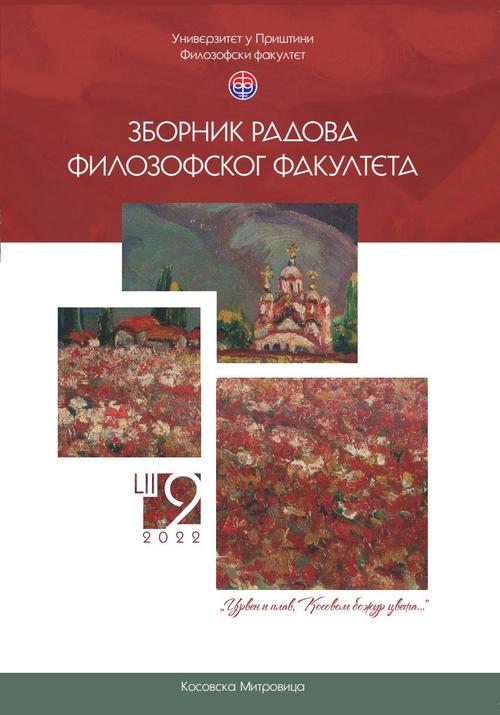Germans in Vojvodina in Times of Establishment of Kingdom of Serbs, Croats, and Slovenes: An Interdisciplinary Approach
Abstract
In this paper, we conducted an interdisciplinary analysis of the process of integration of the German minority in the historical context of the first Yugoslav state, Kingdom of Serbs, Croats, and Slovenes (1918–1929). In 1920, Swabian-German Cultural Association, Kulturbund, was founded as an important factor in preserving the German identity. Even though Kulturbund had interruptions in its activity, in 1924 and 1929, it remained the basic frame for cultural life of the German community during the period between the two wars. Officially, this organization was founded as non-political and loyal to new state, the Kingdom of Serbs, Croats, and Slovenes. The activities of Kulturbund were focused on preservation of German heritage through establishment of cultural institutions such as libraries and bookstores and through organization of cultural events in the area of literature, film, music, and theatre.
Kulturbund was most active in Vojvodina. Vojvodina is still a unique model of co-existence of different ethnic groups and cultural patterns, and the German community historically contributed to multiculturalism, multi-confessionalism and multiethnicity of this region. We based our analyses on contributions in the field of sociology on ethnicity, cultural anthropology, and history. Specifically, we found theoretical model of ethnical boundaries, established by Fredrik Barth within the interactional approach to exploring ethnicity, which proved to be useful. Barth’s influential model allowed us to examine the ethnicity from very important aspect—social interaction. In that way, ethnicity is interpreted as a form of social organization of cultural differences. Also, this model implies that ethnical boundaries are flexible, but also resistant, and can be preserved in situations of intensive cultural contacts between different ethnical and cultural groups. According to Barth, the factors with the most influence to the strengthening of ethnical boundaries are social changes on the international level, such as wars.
References
Антоловић, М. (2013). „Пангерманска аждаја“ и „Змија у недрима“ – српско-хрватски дискурс о Немцима на јужнословенским просторима почетком 20. века. У: С. Марковић (ур.), Друштвени односи Срба и Хрвата, национални идентитет и мањинска права са аспекта европских интеграција, књ. 2 (9–22). Сомбор: Педагошки факултет.
Антоловић, М. (2017). Немачка мањина у Војводини (1918–1941) – друштво и политика. Сомбор: Педагошки факултет.
Бешлин, Б. (2006). Насељавање Немаца у Војводини. Нови Сад: Платонеум.
Вебер, М. (1976). Привреда и друштво I–II. Београд: Просвета.
Јањетовић, З. (2008). Непролазна свакодневица: Немачки допринос народној култури Војводине. Токови историје, 3–4, 214–224.
Јањетовић, З. (2009). Српски утицаји на свакодневну културу Немаца у Војводини. Годишњак за друштвену историју, 2, 19–33.
Крел, А. (2008). Улога удружења „Герхард“ у ревитализацији етничког идентитета сомборских Немаца. У: З. Дивац (ур.), Слике културе некад и сад (155–167). Београд: Етнографски институт САНУ.
Крел, А. (2009). Ревитализација етничког идентитета Немаца у Сремским Карловцима. Гласник Етнографског института САНУ, LVII (1), 71–92.
Крел, А. (2010). „Немачко удружење Адам Беренц“ и ревитализација немачког идентитета Немаца у Апатину. Етноантролошки проблеми, 5 (2), 165–180.
Крел, А. (2014). Немачко удружење Велики Бечкерек: Генератор ревитализације немства у Зрењанину. Етнолошко-антрополошке свеске, 24 (13), 25–44.
Крел, А. (2015). Немци поново у Гакову: сусрети, страдања и помирење некадашњег и садашњег локалног становништва. Гласник Етнографског института САНУ, 63 (2), 283–301.
Марковић, С. (2020). Од присаједињења до прекрајања: Војводина у Краљевини СХС / Југославији 1918–1941. Нови Сад: Архив Војводине.
Павлица, Б. (2005). Судбина Немаца у Србији. Теме, 29 (3), 351–392.
Прелић, М. (2005). Неки проблеми истраживања етницитета/етничког идентитета у културној антропологији. У: Д. Радојичић (ур.), Етнологија и антропологија: стање и перспективе (199–207). Београд: Етнографски институт САНУ.
Bakić, J. (2006). Teorijsko-istraživački pristupi etničkoj vezanosti (Ethnicity), nacionalizmu i naciji. Sociologija, 48 (3), 231–265.
Balaša, V. (2009). Apatinski Nemci: Etnička revitalizacija jedne skrivene manjine. Antropologija, 8, 129–144.
Bart, F. (1997). Etničke grupe i njihove granice. U: F. Putinja i Ž. Stref-Fenar (prir.), Teorije o etnicitetu. Beograd: Biblioteka XX vek.
Bešlin, B. (2001). Vesnik tragedije. Nemačka štampau Vojvodini 1933–1941 godine. Novi Sad: Platoneum.
Ćetković, N. i Sinđelić-Ibrajter, S. (2000). Dunavske Švabice. Beograd: Medijska knjižara Krug.
Dženkins, R. (2001). Etnicitet u novom ključu. Beograd: Bibliteka XX vek.
Đordano, K. (2001). Ogledi o interkulturnoj komunikaciji. Beograd: Biblioteka XX vek.
Eriksen, T. H. (2004). Etnicitet i nacionalizam. Beograd: Biblioteka XX vek.
Gramši, A. (2012). Hegemonija, intelektualci i država. U: J. Đorđević (prir.), Studije kulture (148–154). Beograd: Službeni glasnik.
Janjetović, Z. (2004). Švabe u Vojvodini. U: B. Sikimić (ur.), Skrivene manjine na Balkanu (121–134). Beograd: Institut za balkanske studije.
Janjetović, Z. (2005). Deca careva, pastorčad kraljeva. Beograd: INIS.
Janjetović, Z. (2009). Nemci u Vojvodini. Beograd: INIS.
Janjetović, Z. (2016). Jugoslovenska politika prema manjinama između dva svetska rata. U: K. Glas i dr. (prir.), O „nestanku“ nemačkih nacionalnih manjina: jedno teško poglavlje u istoriji Jugoslavije, 1941–1955. godine (22–32). Ulm: Centralni podunavskošvapski muzej.
Koković, D. i Ristić, D. (2012). Kulturne razlike, etničke granice i etnička distanca: istraživanja u Vojvodini. Teme, 36 (4), 1507–1534.
Krel, A. (2014). Време прикривања: идентитетска стратегија свесног трајног одбацивања и/или привременог прикривања етничког идентитета Немаца у Банату у другој половини 20. века. Antropologija, 14 (2), 89–100.
Lamont, M. & Molnar, V. (2002). The Study of Boundaries in the Social Sciences. Annual Review of Sociology, 28, 167–195.
Lazar, Ž. (Ed.) (2007). Vojvodina amidst Multiculturality and Regionalization. Novi Sad: Mediterran Publishing.
Malešević, S. (2009). Sociologija etniciteta. Beograd: Fabrika knjiga.
Putinja, F. i Stref-Fenar, Ž. (1997). Teorije o etnicitetu. Beograd: Biblioteka XX vek.
Rill, H. i Stojčić, M. (2015). Na tragu Podunavskih Nemaca u Vojvodini. Beograd: Centar za nenasilnu akciju.
The details about the publication policy, including copyright and licensing, are available at:

